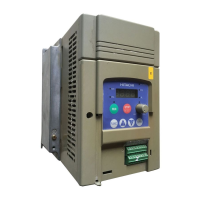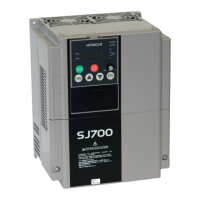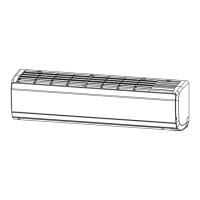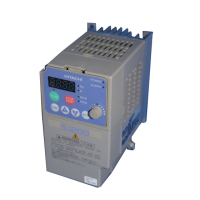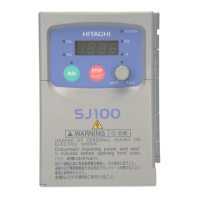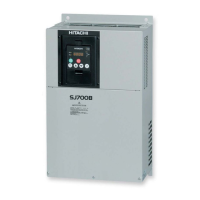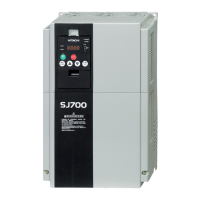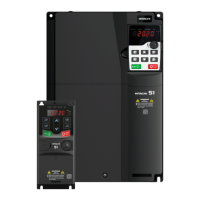SJ300 Inverter Specifications
Geting Started
1–8
Tables for 400V class inverters, continued...
Footnotes for the preceding tables and the table that follows:
Note 1: The protection method conforms to JEM 1030.
Note 2: The applicable motor refers to Hitachi standard 3-phase motor (4-pole). When using
other motors, care must be taken to prevent the rated motor current (50/60 Hz) from
exceeding the rated output current of the inverter.
Note 3: The output voltage decreases as the main supply voltage decreases (except when
using the AVR function). In any case, the output voltage cannot exceed the input
power supply voltage.
Note 4: To operate the motor beyond 50/60 Hz, consult the motor manufacturer for the
maximum allowable rotation speed.
Note 5: When SLV is selected, please set the carrier frequency higher than 2.1 kHz.
Note 6: At the rated voltage when using a Hitachi standard 3-phase, 4-pole motor (when
selecting sensorless vector control—SLV).
Note 7: The braking torque via capacitive feedback is the average deceleration torque at the
shortest deceleration (stopping from 50/60 Hz as indicated). It is not continuous
regenerative braking torque. The average decel torque varies with motor loss. This
value decreases when operating beyond 50 Hz. If a large regenerative torque is
required, the optional regenerative braking resistor should be used.
Note 8: The frequency command will equal the maximum frequency at 9.8V for input voltage
0 to 10 VDC, or at 19.6 mA for input current 4 to 20 mA. If this characteristic is not
satisfactory for your application, contact your Hitachi sales representative.
Note 9: The storage temperature refers to the short-term temperature during transport.
Note 10: Conforms to the test method specified in JIS C0911 (1984). For the model types
excluded in the standard specifications, contact your Hitachi sales representative.
Note 11: NEMA 1 applies up to 22kW. An optional wire-entry conduit box is required for
30kW to 55kW models to meet NEMA 1 rating.
Item 400V Class Specifications
SJ300 inverters,
400V models
U.S. version 750HFU 900HFU 1100HFU — 1500HFU
European ver. 750HFE 900HFE 1100HFE 1320HFE —
Applicable motor size *2 HP 100 125 150 175 200
kW 75 90 110 132 150
Rated capacity (400 / 480V) kVA 103.2 / 123.8 121.9 / 146.3 150.3 / 180.4 180.1 / 216.1 180.1 / 216.1
Rated input voltage 3-phase (3-wire) 380 to 480V ±10%, 50/60 Hz ±5%
Rated input current (A) 164 194 239 286 286
Rated output voltage *3 3-phase (3-wire): 380 to 480V (corresponding to input voltage)
Rated output current (A) 149 176 217 260 260
Efficiency at 100% rated output, % 95.2 95.2 95.2 95.2 95.2
Watt loss,
approximate (W)
at 70% output 2675 3375 3900 4670 4670
at 100% output 3800 4800 5550 6650 6650
Starting torque *6 180% at 0.5 Hz (SLV), 130% at around 0 Hz (SLV, 0 Hz domain,
with motor one frame size down), 100% at 0 Hz (with feedback board)
Dynamic braking
approx. % torque,
short time stop *7
w/o braking unit 10%
with braking unit 45–70% 40–60% 30–50% 25–40% 20–35%
DC braking Variable operating frequency, time, and braking force
Weight kg / lb 60 / 132 60 / 132 80 / 176 80 / 176 80 / 176
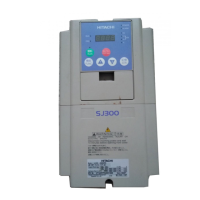
